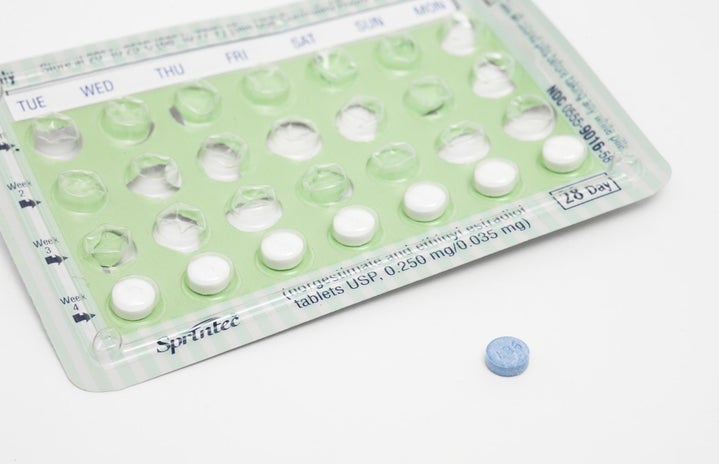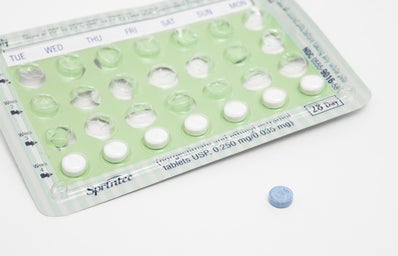Let’s think back to our high-school health class, where our cheeks not-so-innocently flushed at the mere mention of the word “vagina” and we rolled our eyes the millionth time we learned how to use a condom. We learned all about the reproductive system, how to prevent pregnancy, how to protect ourselves from STIs and everything else Coach Carr tried to warn us about in Mean Girls. Because learning how to not get pregnant or not catch an STI from a guy is really all we needed to know, right?
Um, not quite.
While queer girls don’t have to worry about the whole pregnancy deal when having sex with cis girls, we’re definitely not in the clear from STIs. However, our sex ed teacher typically forgot to mention that sex doesn’t necessarily have to happen with a penis and a vagina, so we weren’t taught how to protect ourselves accordingly.
While we’re talking about the Great and All-Powerful V, let’s not forget that not all women have a vagina and not all vaginas belong to women. Trans* women do not always have female genitalia, but that by no means makes them any less of women.
Now that we’ve gotten the logistics out of the way, let’s talk about how we can have some happy, healthy girl-on-girl sex!
Get tested
Lisa Torres, a registered nurse at Harlem Hospital Center, says getting tested is equally important for girls who participate in girl-on-girl sex as girls who have sex with men.
“Females who engage in sex with other females are at risk for a variety of STDs, especially bacterial vaginosis,” Torres says. According to the Centers for Disease Control and Prevention (CDC) website, bacterial vaginosis occurs when too much of a certain bacteria in the vagina messes up the typical bacteria balance. While no one knows the exact causes of BV, the CDC says that having a new partner or multiple partners can unsettle the balance of bacteria in the vagina, which increases the risk of getting infected.
“BV can sometimes be particularly hard to catch due to the fact that it sometimes has no symptoms at all,” Torres says.
Allison Moon, author of Girl Sex 101, says to consider all the possible risks of STIs.
“Queer women may have penises or be having sex with people with penises, too, and that adds certain kinds of risks,” she says. “So really, queer women are at the same risk as anyone for all sorts of STIs. That said, people with vulvas should be most aware of STIs that are spread via skin-to-skin contact, which means herpes and [human papillomavirus].”
Genital herpes can cause breakouts of blisters to form on the genitals, anus, thighs and buttocks. While the breakouts do have periods of dormancy, the carrier of the disease is still contagious.
“Herpes isn’t a huge deal, but it can be painful or embarrassing for some folks,” Moon says. “Most doctors will only test for it if you’ve had an outbreak.”
As the most common STI, nearly all sexually active people have had human papillomavirus, or HPV, at some point in their lives. In most cases, HPV goes away on its own, but in severe cases, it can cause genital warts and even cervical cancer.
“Both of these can be contracted by touching your genitals together, sharing toys or using your hands or mouths on each other,” Moon says.
Another STI that is likely to be transmitted through female-to-female sex is pubic lice. Public lice, or “crabs,” are parasitic insects that can be found in a person’s genital area. It is caused by sexual contact with someone who has pubic lice or personal contact with clothing, bed linens or towels of an infected person.
However, the good news about these infections is that all of them are very easily treated when caught in the earlier stages. Besides the usual STI tests, Torres recommends that you get regular pap smears every two years starting in your 20s or when you start having sex.
Get vaccinated
HPV, Hepatitis A and Hepatitis B are currently the only STIs that have vaccines approved by the FDA.
We’ve all seen the commercials for the HPV vaccine, Gardasil, advocating for us to be “one less.” The vaccine, which consists of three shots over a six-month time period, is recommended for women ages 9 to 26 in order to attain long-lasting protection from four types of HPV.
However, it’s important to note that many women have experienced severe side effects, such as fainting and allergic reactions, from Gardasil. On their own website, Gardasil notes that anyone who is severely allergic to yeast should NOT receive the vaccine. But fortunately, according to Torres, for those who are not allergic to the ingredients of the vaccine, the benefits continue to outweigh the side effects.
Clean your toys
Now, let’s not beat around the bush—some of us love to play around with sex toys in the bedroom, and that is far from uncommon, especially for queer girls. Bringing in vibrators, strap-ons and whatever else tickles your fancy is just another amazing way to bring pleasure to you and your girl—something that neither of you should ever feel ashamed of!
However, it’s crucial to keep these toys properly sanitized, as the fluids they come in contact with can be harmful to your health.
“If you don’t clean your sex toys, you and your partner become at risk for some pretty nasty bacterial infections and STIs,” Torres says. “If you’re using your sex toys with a new partner, I’d also suggest using a condom.”
Depending on the material of your toy, there are different ways in which you can clean it. Fortunately, most toys can be cleaned with a simple antibacterial soap and water.
“It’s important to use nonporous toys if you’ll be sharing them with a partner,” Moon says. “Silicone, stainless steel and Pyrex are all good for this.”
Additionally, you should never use any toys that have rips, tears or cracks in the material. Bacteria can get trapped in the crevices and cannot be cleaned out properly. Moon suggests avoiding jelly rubbers or other cheap materials, which can harbor icky bacteria and don’t come clean easily.
“Silicone and steel are great because you can boil them or throw them in the dishwasher to clean them,” she says. “If you’ll be using the same toy in one session with a partner, the best thing to do is use condoms and switch them out between partners.”
STIs are not the only health problems that can arise from unsanitary sex toys. The bacteria that can build up on a toy that hasn’t been washed well can also cause urinary tract infections, or UTIs, which can be very uncomfortable and painful. Make sure to clean your toys accordingly in order to make sure you both have a fun, safe time.
Use dental dams
While these are probably the more underrated of the safer sex techniques, they are still important to mention. Dental dams are rubber barriers, similar to condoms, which can be put over the vulva or anus in order to engage in safe oral sex.
Fortunately, they’re extremely easy to use: just hold them in place over your partner’s vulva or anus, and you’re good to go! However, it’s important to make sure there are no holes or tears in the dental dam when you open the package.
Dental dams are often treated like the black sheep of the safer sex world due to the fact that people consider them awkward to use and they can inhibit sensation for both the giver and the receiver. Regardless, Moon says dental dams can be a lot of fun.
“They add a neat texture to sex and can help take some of the anxiety out of cunnilingus/analingus. A lot of them come in fun flavors,” Moon says. “I recently used a dental dam with a partner and explored the kinds of sensations I could create by tugging, blowing or snapping the dam against their vulva. It was awesome!”
It’s also extremely easy to make your own DIY dental dam out of condoms and rubber gloves. For a condom, just unroll it, cut the tip off, cut one side of the tube and voila! Similarly, for a rubber glove, you can cut the top four fingers off and cut it down the side opposite from the thumb, and you can insert your tongue into the thumb piece and into your partner while still being safe.
Safe sex for trans* women
So for all of our trans* women collegiettes, we didn’t want to leave you all out, because, as mentioned above, not all women are born with female parts. While recognizing that this topic definitely deserves its own handbook, we just wanted to leave you non-op girls with some quick tips.
First of all, know that disclosing your trans* status should always happen at your own discretion. There’s often fear about coming out, but we know you’ll use your best judgment to make the safest decision for you. Secondly, remember to use a condom in order to prevent yourself from HIV and STIs, as well as birth control.
“Non-op trans women should know that androgen inhibitors are NOT birth control,” Moon says. “Any P-in-V sex will still need a birth control method to prevent pregnancy. If a trans* woman is going to use her penis (or girl dick, outie, etc.) to penetrate a partner, condoms are a must to ensure safer sex.”
Moon also advises that for scissoring or other forms of genital/genital outercourse, using a barrier is a good idea to prevent skin-to-skin STI transmission.
Find a doctor you can trust
One of the concerns many people in the LGBTQ+ community have is finding a doctor with whom who they can be open and honest with in order to receive proper health care. Your health deserves to be taken just as seriously as any other person, so your specific needs should be addressed with your doctor. Fortunately, the Gay and Lesbian Medical Association (GLMA) provides listings for LGBTQ+-friendly health care professionals in your area with the help of their provider directory. Planned Parenthood also offers their services to the LGBTQ+ community, so make sure to check them out as well.
Before you visit a clinic, you can call and ask questions. What are the doctors’ experiences with LGBTQ+ health care? Have they had any LGBTQ+-specific training? Once you arrive at the clinic, you can also look around the waiting room for clues. Be sure to keep an eye out for LGBTQ+-friendly publications, safe zone posters, etc. when you’re in the office.
While this article shouldn’t take the place of professional, one-on-one medical advice, we hope that it will help inspire you to be proactive in making sure you’re taking care of your sexual health needs.
Moon stresses the importance of not only taking care of yourself, but being a role model for healthy sexuality for your peers.
“Too often people silence themselves in the bedroom because of fear or anxiety,” she says. “If you’re aware of your status and can communicate clearly and directly to your sexual partners, you have the power to affect positive change in your community.”
You and your partner will certainly be grateful in the long run as you both engage in fun, stress-free sex. Here’s to a happy, healthy sex life to all the queer women out there!

